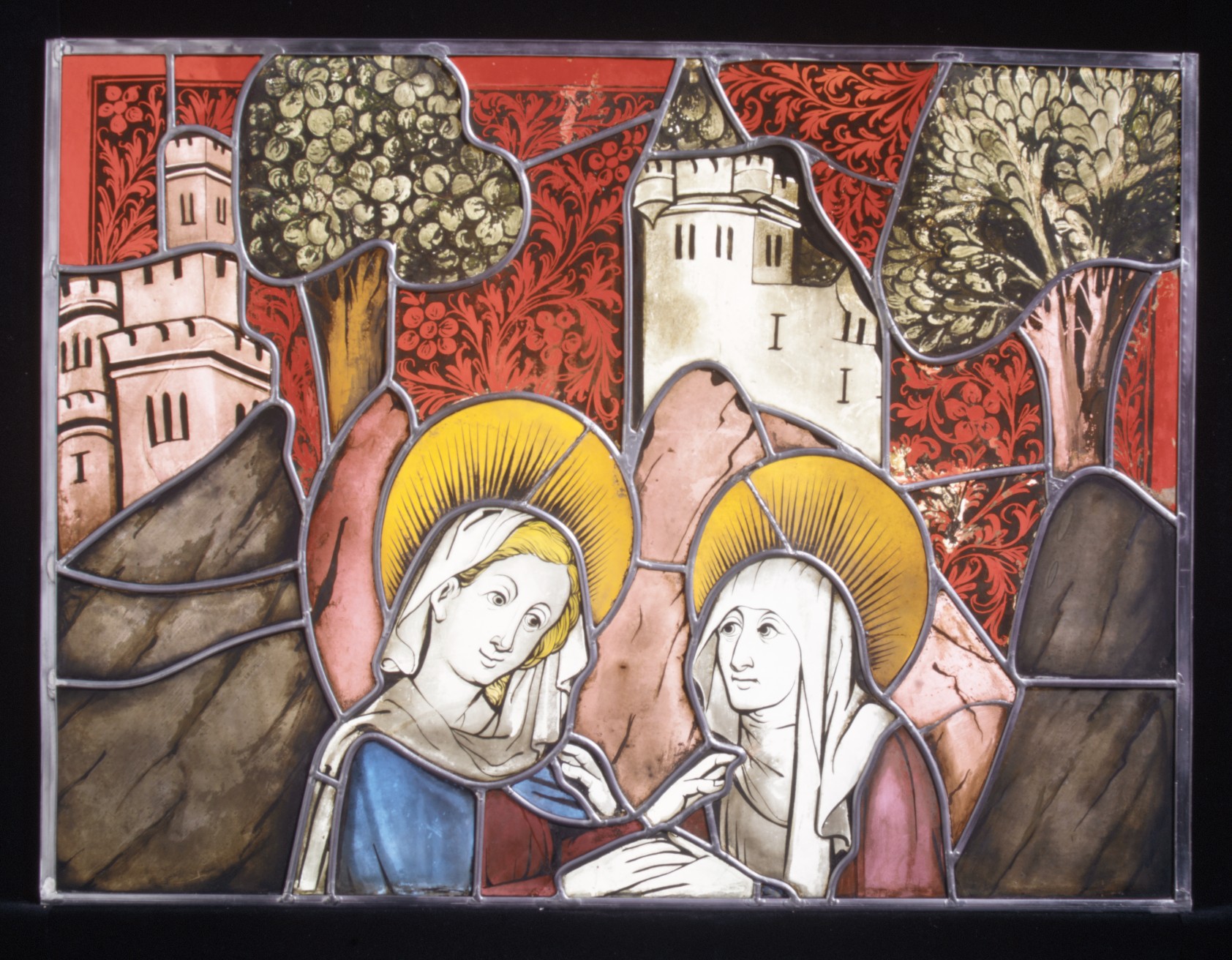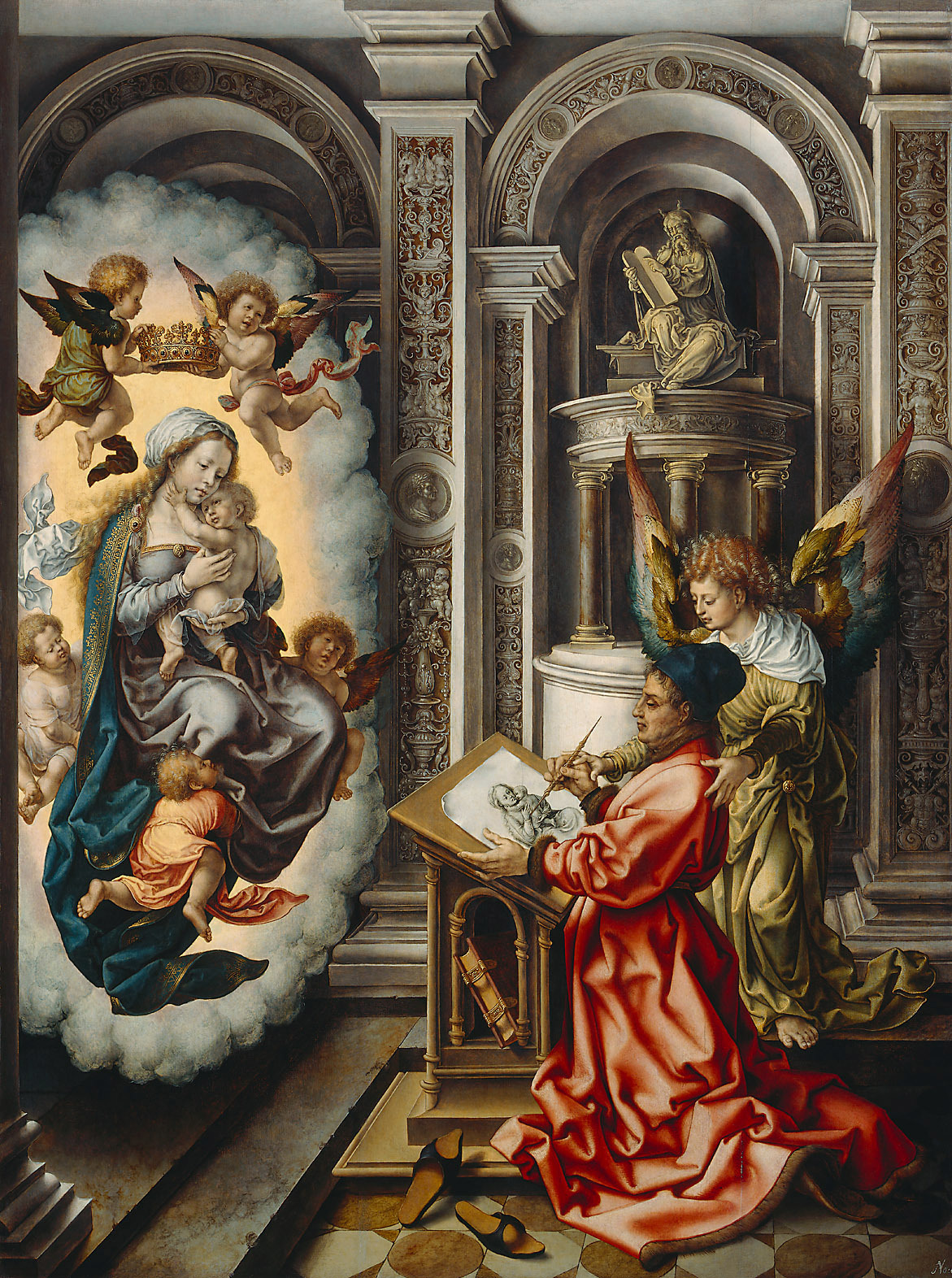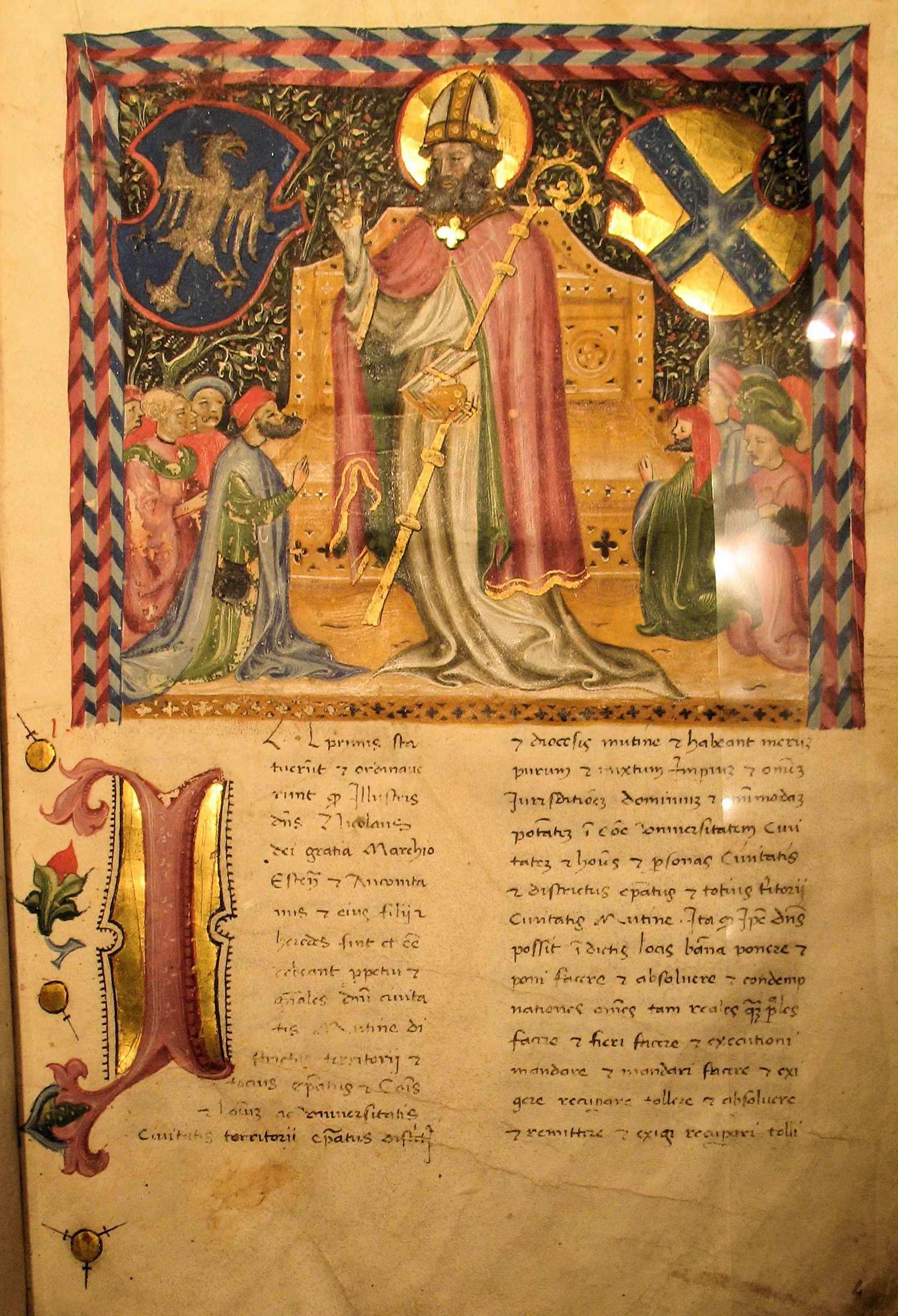|
Gothic Art
Gothic art was a style of medieval art that developed in Northern France out of Romanesque art in the 12th century, led by the concurrent development of Gothic architecture. It spread to all of Western Europe, and much of Northern Europe, Northern, Southern Europe, Southern and Central Europe, never quite effacing more classical styles in Italy. In the late 14th century, the sophisticated court style of International Gothic developed, which continued to evolve until the late 15th century. In many areas, especially Germany, Late Gothic art continued well into the 16th century, before being subsumed into Renaissance art. Primary media in the Gothic period included sculpture, panel painting, stained glass, fresco and illuminated manuscripts. The easily recognisable shifts in architecture from Romanesque to Gothic, and Gothic to Renaissance styles, are typically used to define the periods in art in all media, although in many ways figurative art developed at a different pace. The ear ... [...More Info...] [...Related Items...] OR: [Wikipedia] [Google] [Baidu] [Amazon] |
Chartres Cathedral
Chartres Cathedral (, lit. Cathedral of Our Lady of Chartres) is a Catholic cathedral in Chartres, France, about southwest of Paris, and is the seat of the List of bishops of Chartres, Bishop of Chartres. Dedicated in honour of the Virgin Mary ('Our Lady'), it was mostly constructed between 1194 and 1220. It stands on the site of at least five cathedrals that have occupied the site since the Diocese of Chartres was formed as an episcopal see in the 4th century. It is one of the best-known and most influential examples of High Gothic and Classic Gothic architecture. It was built above earlier Romanesque architecture, Romanesque basements, while its north spire is more recent (1507–1513) and is built in the more ornate Flamboyant style. "[O]ne of the most beautiful and historically significant cathedrals in all of Europe," it was designated a World Heritage Site by UNESCO in 1979, which called it "the high point of French Gothic architecture, French Gothic art" and a "masterpiece ... [...More Info...] [...Related Items...] OR: [Wikipedia] [Google] [Baidu] [Amazon] |
Illuminated Manuscript
An illuminated manuscript is a formally prepared manuscript, document where the text is decorated with flourishes such as marginalia, borders and Miniature (illuminated manuscript), miniature illustrations. Often used in the Roman Catholic Church for prayers and liturgical books such as psalters and courtly literature, the practice continued into secular texts from the 13th century onward and typically include proclamations, enrolled bills, laws, charters, inventories, and deeds. The earliest surviving illuminated manuscripts are a small number from late antiquity, and date from between 400 and 600 CE. Examples include the Vergilius Romanus, Vergilius Vaticanus, and the Rossano Gospels. The majority of extant manuscripts are from the Middle Ages, although many survive from the Renaissance. While Islamic manuscripts can also be called illuminated and use essentially the same techniques, comparable Far Eastern and Mesoamerican works are described as ''painted''. Most manuscripts, ... [...More Info...] [...Related Items...] OR: [Wikipedia] [Google] [Baidu] [Amazon] |
Wilhelm Vöge
Wilhelm Vöge (16 February 1868 – 30 December 1952) was a German art historian, the discoverer of the Reichenau School of painting and one of the most important medievalists of the early 20th century. Whitney Stoddard called him the "father of modern stylistic analysis" for medieval art. Life and work Vöge was born in Bremen. He studied art history under Anton Springer and Paul Clemen at the University of Leipzig, under Carl Justi, Karl Lamprecht and Henry Thode at the University of Bonn, where Aby Warburg and Hermann Ullmann were his classmates, and finally under Hubert Janitschek at the University of Strasbourg. In 1891 he wrote his groundbreaking Ph.D. dissertation on Ottonian painting, based on the Munich manuscript Cim. 58 ("the Evangelary of Otto III"), which established the group of painters known today as the Reichenau School (then however located in Trier). He became a friend of Heinrich Wölfflin. After a research trip in France, where he met the Germa ... [...More Info...] [...Related Items...] OR: [Wikipedia] [Google] [Baidu] [Amazon] |
Île-de-France
The Île-de-France (; ; ) is the most populous of the eighteen regions of France, with an official estimated population of 12,271,794 residents on 1 January 2023. Centered on the capital Paris, it is located in the north-central part of the country and often called the Paris Region (, ). Île-de-France is densely populated and retains a prime economic position on the national stage, and it covers , about 2% of Metropolitan France, metropolitan French territory. Its 2017 population was nearly one-fifth of the national total. The region is made up of eight administrative Departments of France, departments: Paris, Essonne, Hauts-de-Seine, Seine-Saint-Denis, Seine-et-Marne, Val-de-Marne, Val-d'Oise and Yvelines. It was created as the "District of the Paris Region" in 1961. In 1976, when its status was aligned with the French administrative regions created in 1972, it was renamed after the historic province of Île-de-France. Residents are sometimes referred to as ''Franciliens'', an ... [...More Info...] [...Related Items...] OR: [Wikipedia] [Google] [Baidu] [Amazon] |
Painters' Guild
The Guild of Saint Luke was the most common name for a city guild for painters and other artists in early modern Europe, especially in the Low Countries. They were named in honor of the Four Evangelists, Evangelist Saint Luke, Luke, the patron saint of artists, who was identified by John of Damascus as having painted the Mary (mother of Jesus), Virgin's portrait. One of the most famous such organizations was founded in Antwerp. It continued to function until 1795, although by then it had lost its Legal monopoly, monopoly and therefore most of its power. In most cities, including Antwerp, the local government had given the Guild the power to regulate defined types of trade within the city. Guild membership, as a master, was therefore required for an artist to take on apprentices or to sell paintings to the public. Similar rules existed in Delft, where only members could sell paintings in the city or have a shop. The early guilds in Antwerp and Bruges, setting a model that would be ... [...More Info...] [...Related Items...] OR: [Wikipedia] [Google] [Baidu] [Amazon] |
Guild
A guild ( ) is an association of artisans and merchants who oversee the practice of their craft/trade in a particular territory. The earliest types of guild formed as organizations of tradespeople belonging to a professional association. They sometimes depended on grants of letters patent from a monarch or other ruler to enforce the flow of trade to their self-employed members, and to retain ownership of tools and the supply of materials, but most were regulated by the local government. Guild members found guilty of cheating the public would be fined or banned from the guild. A lasting legacy of traditional guilds are the guildhalls constructed and used as guild meeting-places. Typically the key "privilege" was that only guild members were allowed to sell their goods or practice their skill within the city. There might be controls on minimum or maximum prices, hours of trading, numbers of apprentices, and many other things. Critics argued that these rules reduced Free market, fre ... [...More Info...] [...Related Items...] OR: [Wikipedia] [Google] [Baidu] [Amazon] |
Medieval Literature
Medieval literature is a broad subject, encompassing essentially all written works available in Europe and beyond during the Middle Ages (that is, the one thousand years from the fall of the Western Roman Empire ca. AD 500 to the beginning of the Renaissance in the 14th, 15th or 16th century, depending on country). The literature of this time was composed of religious writings as well as secular works. Like modern literature, it is a broad field of study, from the utterly sacred to the exuberantly profane, touching all points in between. Works of literature are often grouped by place of origin, language, and genre. Languages Outside of Europe, medieval literature was written in Geʽez, Ethiopic, Syriac language, Syriac, Coptic language, Coptic, Japanese language, Japanese, Chinese language, Chinese, and Arabic, among many other languages. In Western Europe, Latin was the common language for medieval writing, since Latin was the language of the Roman Catholic Church, which domin ... [...More Info...] [...Related Items...] OR: [Wikipedia] [Google] [Baidu] [Amazon] |
Bourgeois
The bourgeoisie ( , ) are a class of business owners, merchants and wealthy people, in general, which emerged in the Late Middle Ages, originally as a "middle class" between the peasantry and Aristocracy (class), aristocracy. They are traditionally contrasted with the proletariat by their wealth, political power, and education, as well as their access to and control of Cultural capital, cultural, Social capital, social, and financial capital. The bourgeoisie in its original sense is intimately linked to the political ideology of liberalism and its existence within cities, recognised as such by their urban charters (e.g., municipal charters, town privileges, German town law), so there was no bourgeoisie apart from the Burgher (social class), citizenry of the cities. Rural peasants came under a different legal system. In communist philosophy, the bourgeoisie is the social class that came to own the means of production during modern industrialisation and whose societal concerns ar ... [...More Info...] [...Related Items...] OR: [Wikipedia] [Google] [Baidu] [Amazon] |
Medieval University
A medieval university was a corporation organized during the Middle Ages for the purposes of higher education. The first Western European institutions generally considered to be universities were established in present-day Italy, including the Kingdoms of Sicily and Naples, and the Kingdoms of England, France, Spain, Portugal, and Scotland between the 11th and 15th centuries for the study of the arts and the higher disciplines of theology, law, and medicine.de Ridder-Symoens (1992), pp. 47–55 These universities evolved from much older Christian cathedral schools and monastic schools, and it is difficult to define the exact date when they became true universities, though the lists of studia generalia for higher education in Europe held by the Vatican are a useful guide. The word originally applied only to the scholastic guilds—that is, the corporation of students and masters—within the , and it was always modified, as , , or . Eventually, probably in the late 14th centu ... [...More Info...] [...Related Items...] OR: [Wikipedia] [Google] [Baidu] [Amazon] |
Secular
Secularity, also the secular or secularness (from Latin , or or ), is the state of being unrelated or neutral in regards to religion. The origins of secularity can be traced to the Bible itself. The concept was fleshed out through Christian history into the modern era. Since the Middle Ages, there have been clergy not pertaining to a religious order called "secular clergy". Furthermore, secular and religious entities were not separated in the medieval period, but coexisted and interacted naturally. The word ''secular'' has a meaning very similar to profane as used in a religious context. Today, anything that is not directly connected with religion may be considered secular, in other words, neutral to religion. Secularity does not mean , but . Many activities in religious bodies are secular, and though there are multiple types of secularity or secularization, most do not lead to irreligiosity. Linguistically, a process by which anything becomes secular is named ''secularizatio ... [...More Info...] [...Related Items...] OR: [Wikipedia] [Google] [Baidu] [Amazon] |
Mary, The Mother Of Jesus
Mary was a first-century Jewish woman of Nazareth, the wife of Saint Joseph, Joseph and the mother of Jesus. She is an important figure of Christianity, venerated under titles of Mary, mother of Jesus, various titles such as Perpetual virginity of Mary, virgin or Queen of Heaven, queen, many of them mentioned in the Litany of Loreto. The Eastern Orthodox Church, Eastern and Oriental Orthodox, Catholic, Anglican, Methodist, Reformed Christianity, Reformed, Baptist, and Lutheran churches believe that Mary, as mother of Jesus, is the Theotokos, Mother of God. The Church of the East historically regarded her as Christotokos, a term still used in Assyrian Church of the East liturgy. Other Protestant views on Mary vary, with some holding her to have lesser status. She has the Mary in Islam, highest position in Islam among all women and is mentioned numerous times in the Quran, including in a chapter Maryam (surah), named after her.Jestice, Phyllis G. ''Holy people of the world: a cros ... [...More Info...] [...Related Items...] OR: [Wikipedia] [Google] [Baidu] [Amazon] |







